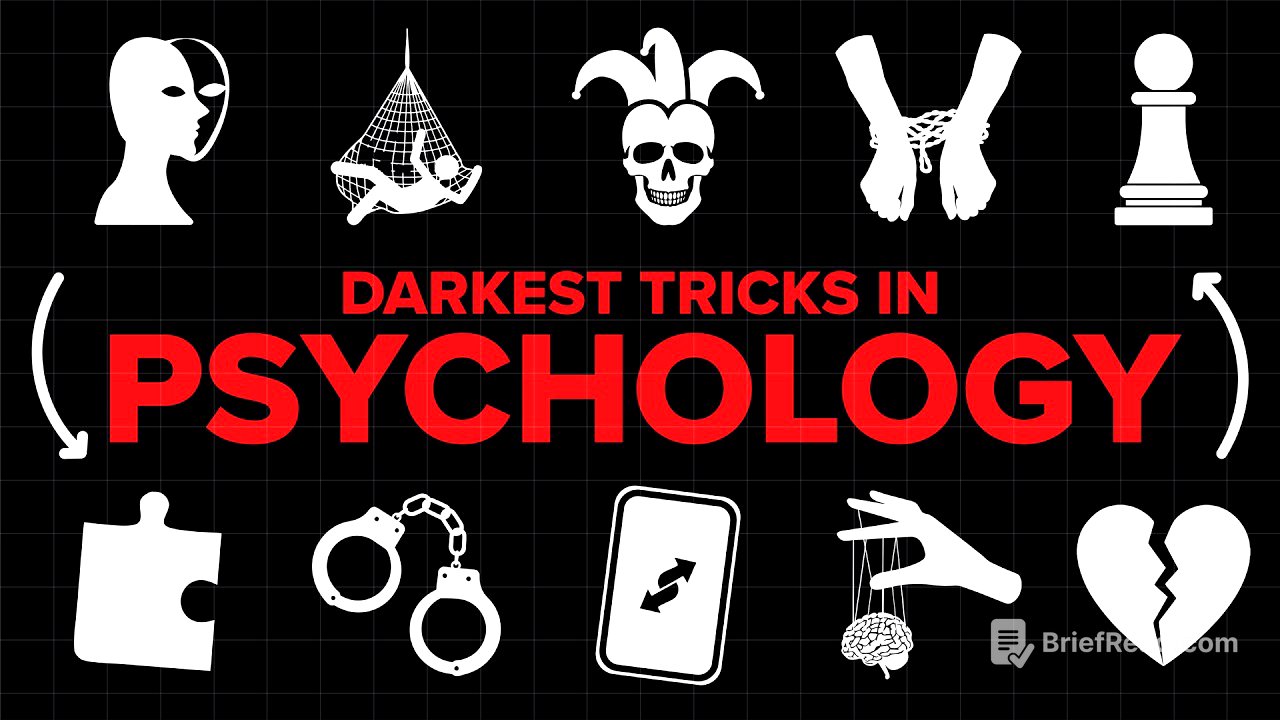TLDR;
This YouTube video transcript explores various psychological manipulation tactics, explaining how they work and how to recognize and resist them. It covers a wide range of techniques, from gaslighting and brainwashing to more subtle methods like exploiting mirror neurons and creating a sense of obligation. The video emphasizes the importance of awareness, critical thinking, and self-worth in protecting oneself from these manipulations.
- Gaslighting: Eroding someone's sense of reality to make them dependent.
- Brainwashing: Systematically altering someone's beliefs through isolation, destabilization, and indoctrination.
- Love bombing: Overwhelming someone with affection to gain control.
- Guilt-tripping: Using guilt to manipulate someone's behavior.
- Cultivating dependence: Making someone believe they cannot survive without the manipulator.
- Learned helplessness: Causing someone to believe escape is impossible.
- Stockholm syndrome: Developing a bond with one's captor as a survival mechanism.
- Memory manipulation: Altering or implanting false memories.
- Fear-mongering: Using fear to control people.
- Emotional blackmail: Exploiting emotions to get what one wants.
- Playing on insecurities: Targeting someone's deepest fears to manipulate them.
- Triangulation: Introducing a third party to create tension and insecurity.
- Public shaming: Using humiliation to control behavior.
- Hoovering: Sucking someone back into a toxic cycle.
- Cognitive dissonance: Forcing someone to justify their own suffering.
- Exploiting mirror neurons: Using mirroring to manufacture attraction and loyalty.
- Exploiting empathy: Using someone's compassion against them.
- Creating a sense of obligation: Using favors to create a sense of debt.
- Divide and conquer tactics: Breaking apart unity to consolidate power.
- Authority bias: Exploiting the tendency to trust authority figures.
- Scapegoating: Blaming a single person or group for problems they didn't create.
- Social proof exploitation: Manipulating the tendency to follow the crowd.
- Groupthink induction: Suppressing dissent to create a false sense of unity.
- Cultivating false identity: Creating a persona to manipulate others.
- The seeds of self-doubt: Planting doubts to erode confidence.
- Emotional contagious exploitation: Manipulating emotions to control people.
- The illusion of choice: Limiting options to control decisions.
- Anchoring effect: Manipulating perception of value with reference points.
- Framing effect manipulation: Shaping opinions by presenting facts in a certain way.
- Conformation bias reinforcement: Reinforcing existing beliefs to control thinking.
- The Baader-Meinhof Phenomena: Manipulating perception by introducing a concept and then making it appear everywhere.
- Mirror and Matching: Building rapport by mirroring body language and speech.
- Pacing and Leading: Gaining trust by agreeing with someone before leading them.
- Neuro-Linguistic Programing: Influencing thoughts and behaviors through language and subconscious cues.
- Subliminal Messaging: Planting messages in the mind without conscious awareness.
- Priming Effect: Influencing behavior by subtly introducing an idea.
- Suggestive Language and Hypnosis: Shaping perception through carefully worded statements.
- Creating a Sense of Urgency: Bypassing rational thinking by creating a sense of urgency.
- Foot In The Door Technique: Gaining compliance by starting with a small request.
- Door In The Face Technique: Gaining compliance by starting with a large request and then reducing it.
- Low Balling: Gaining commitment by starting with a low price and then increasing it.
- Bandwagon Effect Manipulation: Exploiting the fear of being left out.
- Creating A Sense of Scarcity: Making something seem more desirable by limiting its availability.
- Exploiting the Need for Closure: Keeping people hooked by dangling half-revealed secrets.
- Micro Manipulation: Controlling people's decisions through subtle tactics.
- The Zeigarnik Effect: Exploiting the tendency to remember unfinished tasks.
- The Pygmalion Effect: Shaping behavior through expectations.
- Reframing Failure: Manipulating how someone perceives their own mistakes.
- The Halo Effect: Distorting perception by focusing on one positive trait.
- Time Constraints: Pressuring people to act quickly.
- The Contrast Principle: Altering perception of value by comparing things.
- The Ikea Effect: Making people overvalue things they've put effort into.
- Decoy Effect: Influencing decisions by presenting a third, less attractive option.
- The Placebo Effect: Exploiting the power of belief to change the body.
- Loss Aversion: Making people fear losing more than they desire winning.
- Power of Touch: Influencing thoughts and decisions through physical contact.
- The Foot In The Mouth Effect: Exploiting the need to be perceived as kind.
- The Endowment Effect: Making people overvalue things they own.
- Mind Control: Systematically breaking down personal identity.
- Power of Playing Dumb: Gaining the upper hand by appearing less intelligent.
Gaslighting [0:00]
Gaslighting is a psychological manipulation tactic used to make someone question their own perception of reality. It involves denying things that have been said or done, attacking the victim's ability to think clearly, and emotionally manipulating them. The ultimate goal is to isolate the victim and make them dependent on the manipulator for their sense of reality.
Brain-Washing [3:20]
Brainwashing is a powerful psychological manipulation that involves a radical transformation of someone's beliefs and values. It typically follows a pattern of isolation, destabilization, indoctrination, and reinforcement. By controlling the information someone has access to, breaking down their mental defenses, and implanting new beliefs through reward and punishment, brainwashing can make people want to change.
Love Bombing [7:39]
Love bombing is a psychological trick designed to make someone emotionally dependent before pulling the rug out from under them. It involves flooding the victim with extreme attention, affection, and compliments. Once the victim is hooked, the manipulator begins to withdraw, leaving the victim scrambling to regain the initial euphoria.
Guilt-Tripping [10:37]
Guilt-tripping is a powerful psychological weapon that involves making someone feel guilty for not doing what the manipulator wants. It often involves subtly twisting reality to make the victim feel responsible for the manipulator's suffering. Shame inducement, which makes the victim feel bad about who they are, is an even more potent form of control.
Cultivating Dependence [14:13]
Cultivating dependence is a manipulation tactic designed to make people believe they cannot survive without the manipulator. It involves removing options one by one, isolating the victim, and becoming the sole source of validation and security. The victim stops making choices for themselves, believing they are incapable of doing so.
Learned Helplessness [16:54]
Learned helplessness is a psychological state in which someone stops seeing escape as an option, even when it exists. It occurs when someone is placed in a situation where they experience repeated punishment, failure, or isolation. The brain prioritizes safety over freedom, and the victim becomes passive and submissive.
Stockholm Syndrome [20:13]
Stockholm syndrome is a psychological response in which a hostage or abuse victim develops a bond with their captor. It occurs when a person is trapped and powerless, and their brain starts looking for ways to cope. Small acts of mercy from the captor can create a twisted reality in which the victim sees their captor as their savior.
Memory Manipulation [23:13]
Memory manipulation is the act of planting a false memory in someone's mind, which they then believe as firmly as their real experiences. Memory is fragile and easily manipulated, and with the right influence, someone can alter your past, reshape your emotions, and even convince you of things that never happened. Suggestion and reinforcement are key tools in memory manipulation.
Fear-Mongering [26:45]
Fear-mongering is a form of control that overrides logic and crushes independent thought. When someone is afraid, they don't analyze or question; they just want to feel safe. Manipulators use fear to create anxiety and then offer themselves as the only solution.
Emotional Blackmail [29:41]
Emotional blackmail is a psychological manipulation tactic where someone exploits your emotions, fear, guilt, and obligation to get what they want. They make you feel like denying them is cruel, selfish, or even dangerous. The key to breaking free is recognizing the pattern and refusing to play the game.
Playing On Insecurities [33:11]
Playing on insecurities involves identifying someone's deepest fears or desires and then twisting them to control their behavior. The goal is to make the victim dependent on the manipulator's reassurance, approval, and protection. Insecurities cloud judgment, making the victim more willing to prove their worth, even at their own expense.
Triangulation [36:45]
Triangulation is a manipulation tactic that introduces a third person, real or imagined, into a dynamic to create tension, competition, or insecurity. It's a classic move in toxic relationships, workplaces, and even politics. The victim starts to compete for validation, feeling replaceable and working harder to prove themselves.
Public Shaming [40:34]
Public shaming is a tool of control that strips a person of their dignity, isolates them from their community, and turns them into a cautionary tale. It's about breaking a person down so completely that they accept their own destruction. The fear of social rejection is a key factor in the effectiveness of public shaming.
Hoovering [44:09]
Hoovering is a tactic designed to suck someone back into a toxic cycle right when they think it's over. It's used by narcissists, emotional abusers, and manipulators who can't stand losing control. The trick works because it preys on hope that things will finally be different this time.
Cognitive Dissonance [47:18]
Cognitive dissonance happens when someone holds two conflicting beliefs at the same time, creating an unbearable tension in the mind. Manipulators amplify this tension to make people double down instead of walk away. The trick is escalation, convincing you to accept a minor contradiction and then gradually increasing the demands.
Exploiting Mirror Neurons [51:34]
Mirror neurons are specialized brain cells that fire not just when you act, but when you see someone else acting. Manipulators exploit these neurons by mirroring your emotions, posture, and tone to make you feel at ease. This can manufacture attraction, loyalty, and compliance.
Exploiting Empathy [55:17]
Empathy, often seen as a strength, can be weaponized by manipulators. They create a problem that makes someone feel responsible and then present themselves as the only solution. This can lead to compassion fatigue, where the victim breaks down from exhaustion and gives in.
Creating A Sense of Obligation [57:33]
The need to reciprocate kindness is natural, but when used as a tool for control, it becomes something else entirely. Manipulators give small favors, compliments, or helping hands until the sense of debt grows. When they call in that debt, rejecting them feels like breaking an unspoken contract.
Divide and Conquer Tactics [1:00:26]
Divide and conquer is a manipulation strategy that breaks apart unity, making sure people are too distracted by conflict to notice who's pulling the strings. It works by creating distrust and isolation, making people dependent on the manipulator for validation and direction.
Authority Bias [1:02:50]
Authority bias is our instinctive tendency to trust and obey those we see as powerful, knowledgeable, or in charge. Manipulators exploit this bias by creating an illusion of infallibility, overriding morality, logic, and even self-preservation.
Scapegoating [1:06:05]
Scapegoating is the art of blaming a single person or group for problems they didn't create. It's a tactic so powerful that it has fueled witch hunts, toppled governments, and destroyed countless lives. It works because people crave simple answers to complex problems.
Social Proof Exploitation [1:09:09]
Social proof is the instinct to follow the crowd, assuming that if many people believe or do something, it must be right. Manipulators exploit this bias by manufacturing credibility where none exists, making people believe everyone else is doing it and they'll follow.
Groupthink Induction [1:11:53]
Groupthink is a psychological phenomenon where the need for unity overrides logic, skepticism, and even self-preservation. It creates an environment where disagreement feels like betrayal, and people stop thinking critically.
Cultivating False Identity [1:14:11]
Some manipulators don't just lie; they become the lie. They shape their identities to fit whatever will make people trust them, molding themselves into whoever they need to be. This isn't just deception; it's performance.
The Seeds of Self Doubt [1:16:19]
The most insidious form of control doesn't come from force or coercion; it comes from planting a simple thought: what if I'm not good enough? This is the art of sowing self-doubt, a psychological trick that can dismantle confidence, reshape reality, and keep someone locked in a cycle of second-guessing themselves.
Emotional Contagious Exploitation [1:19:12]
Emotional contagion is the subconscious transfer of emotions from one person to another. Manipulators use this to control people without ever needing to say "do this." Instead, they create an emotional atmosphere that makes people want to comply.
The Illusion of Choice [1:22:00]
The illusion of choice is one of the most deceptive and manipulative psychological tricks ever used. It makes you feel like you're in charge when, in reality, you're just following a predetermined path. The key is that people don't usually question the choices they're given.
Anchoring Effect [1:25:01]
Anchoring bias is a cognitive bias that describes the common human tendency to rely too heavily on the first piece of information offered (the "anchor") when making decisions. During decision making, anchoring occurs when individuals use an initial piece of information to make subsequent judgments.
Framing Effect Manipulation [1:28:36]
The framing effect is a cognitive bias where people decide on options based on if the options are presented with positive or negative connotations; e.g. as a loss or as a gain.
Conformation Bias Reinforcement [1:32:14]
Confirmation bias is the tendency to search for, interpret, favor, and recall information in a way that confirms one's pre-existing beliefs or hypotheses. It is a type of cognitive bias and a systematic error of inductive reasoning.
The Baader-Meinhof Phenomena [1:35:59]
The Baader-Meinhof phenomenon, also known as the frequency illusion, is a cognitive bias in which, after noticing something new, a person starts to see it everywhere. This often leads them to believe it is occurring more frequently.
Mirror and Matching [1:38:28]
Mirroring is a subtle technique that involves unconsciously imitating another person's behavior, such as their speech patterns, gestures, and body language. It's a way to create rapport and build trust, as people tend to feel more connected to those who seem similar to them.
Pacing and Leading [1:42:11]
Pacing and leading is a communication technique used to establish rapport and guide someone towards a desired outcome. It involves first "pacing" the other person by mirroring their behavior, acknowledging their feelings, and agreeing with their perspective. Once a connection is established, you can then begin to "lead" them by subtly shifting the conversation or suggesting new ideas.
Neuro-Linguistic Programing [1:44:18]
Neuro-linguistic programming (NLP) is a pseudoscientific approach to communication, personal development, and psychotherapy. It posits that there is a connection between neurological processes ("neuro"), language ("linguistic") and behavioral patterns learned through experience ("programming"), and that these can be changed to achieve specific goals in life.
Subliminal Messaging [1:46:30]
Subliminal stimuli are any sensory stimuli below an individual's threshold for conscious perception. A variety of stimuli can be subliminal, including auditory and visual stimuli.
Priming Effect [1:50:34]
Priming is a cognitive bias that occurs when exposure to one stimulus influences a response to a subsequent stimulus, without conscious awareness. It can affect various aspects of cognition, including perception, memory, and decision-making.
Suggestive Language and Hypnosis [1:54:19]
Suggestive language is a way to influence someone's thoughts and actions by using words and phrases that imply or hint at a desired outcome. Hypnosis is a state of heightened suggestibility that can be induced through various techniques, such as relaxation exercises and guided imagery.
Creating a Sense of Urgency [1:58:30]
Creating a sense of urgency is a persuasion technique used to make people feel like they need to act quickly, or they will miss out on a valuable opportunity. It often involves using phrases like "limited time offer," "while supplies last," or "don't miss out."
Foot In The Door Technique [2:01:43]
The foot-in-the-door (FITD) technique is a compliance tactic that aims at getting a person to agree to a large request by having them agree to a modest request first.
Door In The Face Technique [2:04:13]
The door-in-the-face (DITF) technique is a compliance method whereby the persuader attempts to convince the respondent to comply by making a large request that the respondent will most likely turn down, much like a metaphorical slamming of a door in the persuader's face. The respondent is then more likely to agree to a second, more reasonable request, compared to the same reasonable request made in isolation.
Low Balling [2:07:18]
Low-balling is a persuasion and compliance tactic in which an item or service is initially offered at a lower price than is actually intended to be charged; the price is then raised to increase profits.
Bandwagon Effect Manipulation [2:09:41]
The bandwagon effect is a psychological phenomenon in which people do or believe things because many other people do or believe the same. This can be used to manipulate people into following trends or adopting certain beliefs.
Creating A Sense of Scarcity [2:12:09]
Scarcity is a technique used to influence people to buy a product or service by making them believe that it is in short supply. This can be done by limiting the number of items available, or by creating a sense of urgency, such as a limited-time offer.
Exploiting the Need for Closure [2:14:20]
The need for closure is a psychological concept that describes the desire for a firm answer to a question and an aversion toward ambiguity. This can be exploited by manipulators to keep people hooked and anxious.
Micro Manipulation [2:18:28]
Micromanipulation refers to subtle, almost imperceptible tactics used to control people's decisions, beliefs, and behaviors without them noticing. Unlike obvious coercion or deception, micromanipulation works like slow poison, drip by drip, making small adjustments that push you exactly where they want you.
The Zeigarnik Effect [2:22:05]
The Zeigarnik effect is a psychological phenomenon that describes the tendency to remember incomplete or interrupted tasks better than completed ones. This can be exploited to keep people hooked, anxious, and desperate for closure.
The Pygmalion Effect [2:24:08]
The Pygmalion effect is a psychological phenomenon in which high expectations lead to an increase in performance. This can be used to manipulate people by setting high expectations for them, which can lead them to perform better, but also to feel pressure and anxiety.
Reframing Failure [2:26:20]
Reframing failure is a subtle yet devastating psychological trick. It's a way to manipulate how you perceive your own mistakes, making you feel powerless, incompetent, or even guilty.
The Halo Effect [2:30:09]
The halo effect is a cognitive bias in which our overall impression of a person influences how we feel and think about their character. It's a psychological trick so subtle yet so manipulative that it can make someone appear smarter, kinder, or even more trustworthy than they actually are simply because of one positive trait.
Time Constraints [2:34:02]
Time constraints are a pressure tactic and it's one of the most effective ways to make people act against their better judgment. When faced with a ticking clock, rational thinking is the first thing to collapse.
The Contrast Principle [2:37:30]
The contrast principle is a psychological trick that alters how we perceive value, making things seem better or worse depending on what they are compared to.
The Ikea Effect [2:41:36]
The Ikea effect is a cognitive bias in which people place a disproportionately high value on objects that they partially assembled themselves, regardless of the quality of the end result.
Decoy Effect [2:44:28]
The decoy effect is a cognitive bias in which consumers will tend to have a specific change in preference between two options when also presented with a third option that is asymmetrically dominated.
The Placebo Effect [2:47:06]
The placebo effect is a phenomenon in which a fake treatment can improve a patient's condition simply because the patient expects it to work.
Loss Aversion [2:49:59]
Loss aversion is a cognitive bias that describes the tendency for people to feel the pain of a loss more strongly than the pleasure of an equivalent gain.
Power of Touch [2:52:35]
Touch is a psychological weapon so subtle that most people never even notice when it's being used against them and yet it can shape behavior in ways that are almost impossible to resist.
The Foot In The Mouth Effect [2:56:28]
The foot-in-the-mouth effect is a compliance technique that involves getting someone to acknowledge that they are in a good mood before making a request. This makes them more likely to comply with the request, as they want to maintain consistency between their words and actions.
The Endowment Effect [3:01:20]
The endowment effect is a cognitive bias that describes the tendency for people to demand a higher selling price for an object they own than they would be willing to pay to acquire it.
Mind Control [3:04:21]
Mind control is a process by which individual or collective thought self-determination is compromised by agents or processes that exploit vulnerabilities in the target's psychology.
Power of Playing Dumb [3:07:27]
Playing dumb is a carefully crafted manipulation tool, a way to control situations, lower people's defenses, and gain the upper hand without them ever realizing it.









